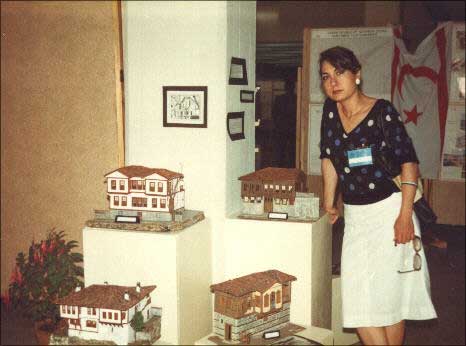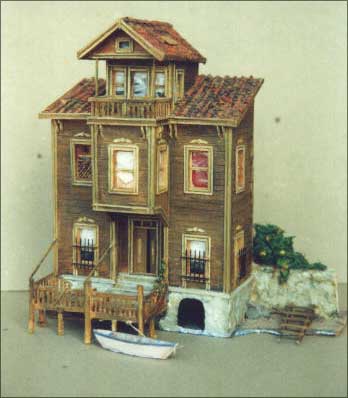
Main Page | English-2 | Ataturk's Houses | Guest Book

Main Page | English-2 | Ataturk's Houses | Guest Book

About Me
Hello! My name is Sule Ulgen. I am a Turkish artist
who makes models of old Turkish houses.
I was born in Istanbul and traveled all around
Turkey with my father who was an army officer.
I am married to Ender Ulgen, a Turkish
journalist, and we have a daughter. Since 1994 I have been living in New
York, where my husband works.
My Aim
I am a romantic and an artist looking back and living
in nostalgia. I always admired the elegance and romantic views of old houses in
Istanbul and I found it painful to see them disappearing one after another
because of lack of care, falling prey to fires or been victimized by the rapid
urbanization.
I tried to find out what I could do to
help them survive and in 1980, after some trials, I started to create my
models. My aim was to make my generation more aware of the beauty of these houses,
and also to help preserve them for the next generations.
My Background
Having no formal training in model making I have
basically developed my models and techniques on my own. People have been impressed
with my ability to reflect the architectural differentiation of various regions of Turkey.
I have had several exhibitions between 1981 and
1993, first in Turkey, in Ankara and Istanbul; then in Brussels,
at the CGER-ASLK Bank and in an international tourism fair; in Antwerp within
the context of the ''Goodmorning Anatolia'' Exhibit; in Paris, at ''Musee de
l'Homme'' and in the UNESCO Building; as well as in ''Royal Cultural Center''
in Amman, Jordan.

Also, several TV chains press media have
produced programs related to my models and my art.
My hobbies include drawing and painting
(charcoal and oils), cold ceramics and poetry. Currently I am taking notes
for a future book which will reflect my memoirs of New York.
![]()
General
Characteristics of Turkish Houses
Turkish houses were started to proliferate within the
large boundaries of the Ottoman Empire as of the 15th Century. They were built in
such a way as to allow three generations live altogether under the same roof.
There are in various types, such as yali (waterfront houses), konak (mansions), kiosks, as
well as regular houses for the middle class.
It is obvious that Turkish houses reflect the
characteristics of the vicinity where they stand, but they also have some common features.
For instance they all have cages, bay windows, shutters and large eaves on the facade and
outside of the buildings; while internally one can see large cabinets, sofas and washing
places inserted within cabinets, fire places and even marble fountains.
First floors were usually assigned to cellars,
rooms for servants and stables.
On the second floors, there were hallways and
large rooms. Here, one can see richly decorated walls and ceilings, in contrast with
the humble appearance of the buildings' exteriors. Gardens were protected from
alien eyes with high rise walls.
Unfortunately it is very difficult to preserve those
houses, built essentially by wood and mud-bricks; so they disappear because of climatic
factors, some inevitable fires or just because of the rapid urbanization.
I hope I am helping to preserve a little piece
of architectural history through my models.
![]()
Some of My Models

The house of the eminent Turkish composer Hammamizade
Ismail Dede Efendi. It is in Cankurtaran district of Istanbul and recently repaired
and transformed into a museum by the Association to Protect Historical Turkish Houses.
Actually there is an old Turkish musical instruments exhibit in the museum.
The fountain next the house was a perfect
example of stone carving and was built in the name of the Ottoman Sultan
Mahmut, the IInd.
(The model was completed in 6 months. Scale: 1/50).

Amcazade Huseyin pasa’s yali (waterfront
house). This is the oldest waterfront house in Bogazici (Bosphorus) in Istanbul. It was
built in 17th century and just the council chamber can stand erect till today. It
has a (T) shape, painted in red and richly decorated internally, with a fountain in the
middle of the hall. Eminent statesmen were entertained in this building. There were large
seats under the windows and people sitting there can watch the Bosphorus as they are
in the sea.
(The model was completed in 4.5 months. Scale:
1/50).

House of Istanbullu Ahmet, in Safranbolu.
In Safranbolu, northwestern Anatolia, the majority of
old wooden houses were actually under a preservation program initiated by UNESCO,
the UN Cultural & Educational Organization, so the whole city can be called a
‘’museum town’’.
(The model was completed in 5 months 10 days.
Scale: 1/50).

A characteristic Istanbul wooden house at
Goksu/Istanbul.
(The model was completed in 22 days)

A typical Istanbul house in Buyukdere, Istanbul.
(The model was completed in 30 days)
If you would like to see more of my models, please click
E-mail: eulgen@aol.com
This Web Page was created by ENDER ULGEN
using Netscape Composer.